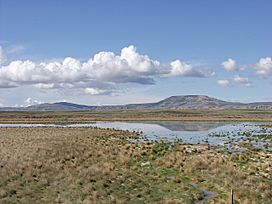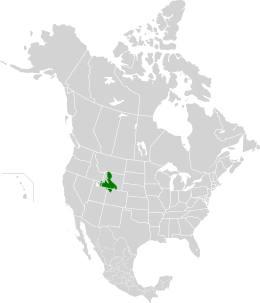Wyoming Basin shrub steppe facts for kids
Quick facts for kids Wyoming Basin shrub steppe |
|
|---|---|

Ephemeral wetland in the Red Desert of south-central Wyoming
|
|
 |
|
| Ecology | |
| Realm | Nearctic |
| Biome | Deserts and xeric shrublands |
| Borders | |
| Bird species | 189 |
| Mammal species | 83 |
| Geography | |
| Area | 132,348 km2 (51,100 sq mi) |
| Country | United States |
| States | Wyoming, Colorado, Utah, Idaho and Montana |
| Conservation | |
| Habitat loss | 4.5412% |
| Protected | 42.58% |
The Wyoming Basin shrub steppe is a special natural area in the northwestern United States. It's a type of shrub steppe, which means it's a dry land covered mostly by shrubs and grasses. This area is part of a larger group of places called deserts and xeric shrublands, known for their dry weather.
Contents
Where is the Wyoming Basin Shrub Steppe?
This unique natural area is mostly found in the state of Wyoming in the United States. It also stretches a little bit into nearby states like southeastern Idaho, south-central Montana, north-central Utah, and northwestern Colorado.
Surrounded by Mountains
The Wyoming Basin shrub steppe sits in high-altitude basins. These are like large bowls of land. They are mostly surrounded by different parts of the Rocky Mountains.
A Dry and Cold Climate
This region is in a "rain shadow". This means the tall mountains block most of the rain clouds. Because of this, the area has a very dry or semi-dry climate. Winters here are long and very cold, while summers are short and hot.
Plants of the Wyoming Basin
The main plant you'll see in this area is a type of sagebrush called Artemisia tridentata. It often grows with different kinds of Agropyron grass or fescue grass.
Where the Shrub Steppe Meets Forests
As you go higher up in the mountains, the shrub steppe slowly changes. It turns into the South Central Rockies forests, the Colorado Rockies forests, and the Wasatch and Uinta montane forests. These areas where two different types of environments meet are called ecotones. Sometimes, these meeting points can be as high as 3,000 meters (about 9,800 feet) above sea level.
Where the Shrub Steppe Meets Other Dry Lands
Between the mountain ranges, this region also connects with other dry areas. To the east and a small part of the north, it meets the Northern short grasslands. To the south, it connects with the Colorado Plateau shrublands. A very small part in the far west touches the Great Basin shrub steppe.
Animals of the Wyoming Basin
Many interesting animals live in the Wyoming Basin shrub steppe.
Mammals of the Shrub Steppe
You might spot large mammals like elk (Cervus canadensis) and pronghorn (Antilocapra americana). There are also smaller animals such as the white-tailed prairie dog (Cynomys leucurus) and the coyote (Canis latrans). Sometimes, you can even see bison (Bison bison bison) and the very rare black-footed ferret (Mustela nigripes). The swift fox (Vulpes velox) also makes its home here.
Birds of the Shrub Steppe
Many birds depend on the sagebrush for their homes and food. These include the greater sage-grouse (Centrocercus urophasianus), sagebrush sparrow (Artemisiospiza nevadensis), Brewer's sparrow (Spizella breweri), and sage thrasher (Oreoscoptes montanus).
In areas with less sagebrush, you might find birds that prefer grasslands or semi-deserts. Some examples are the long-billed curlew (Numenius americanus), western meadowlark (Sturnella neglecta), lark sparrow (Chondestes grammacus), and vesper sparrow (Pooecetes gramineus). Other birds include the thick-billed longspur (Rhynchophanes mccownii), mountain plover (Charadrius montanus), and loggerhead shrike (Lanius ludovicianus).
Reptiles of the Shrub Steppe
Common reptiles in this dry area include the sagebrush lizard (Sceloporus graciosus). You might also see the greater short-horned lizard (Phrynosoma hernandesi), sometimes called a "horned toad." The prairie rattlesnake (Crotalus viridis viridis) also lives here.
Protecting the Wyoming Basin
Even though only a small part of this natural area is officially protected, much of it is still in good condition. This is mainly because the harsh climate makes it difficult for farming.
Challenges to the Environment
However, some activities have changed parts of the region.
- Heavy livestock grazing: Too many animals eating plants can change the land.
- Fire suppression: Stopping natural fires can change how plants grow.
- Non-native plants: New plants brought into the area can take over from native ones.
- Oil and gas exploration and mining: These activities can disturb the land and wildlife.
These challenges are the biggest threats to keeping the Wyoming Basin shrub steppe healthy and natural.

